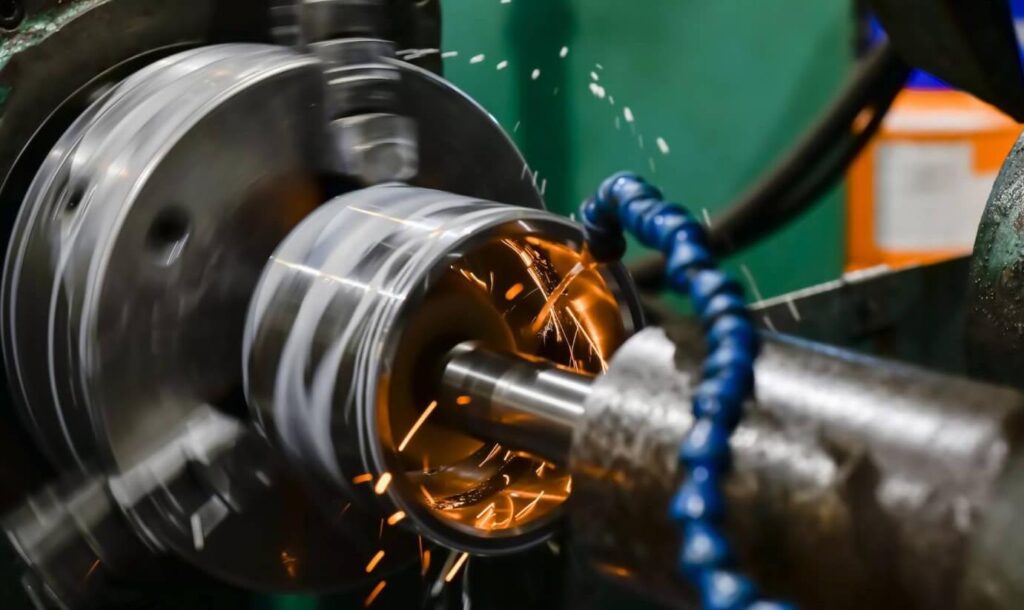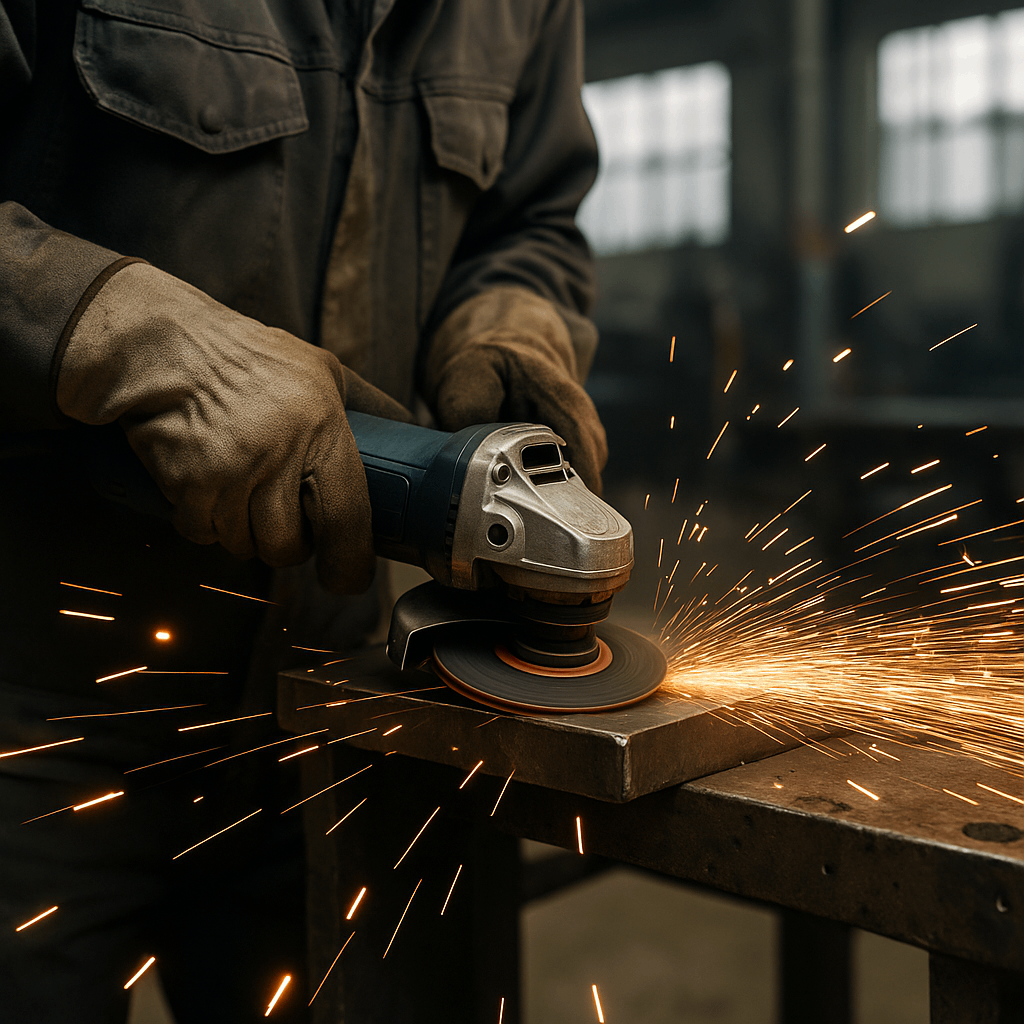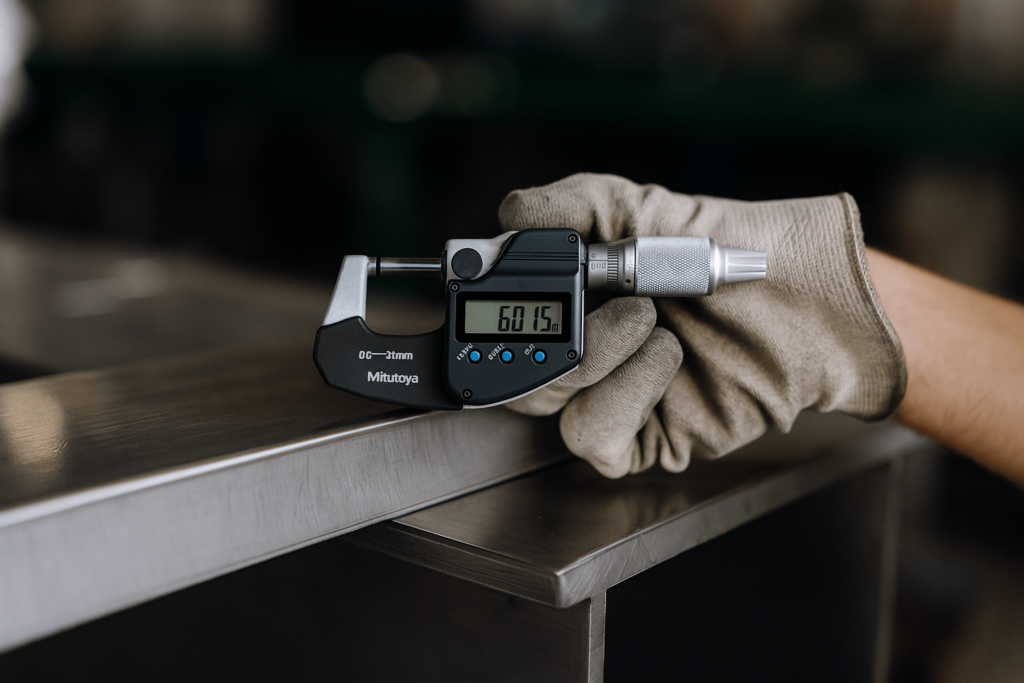Grinding—Why Sourcing Teams Specify It Before Problems Begin
Why Grinding Decides Whether a Metal Part Fails or Performs
In high-stakes B2B fabrication—medical housings, enclosure systems, energy modules—grinding isn’t just a surface process. It’s the difference between cosmetic rejection and functional acceptance.
Procurement teams often specify tolerances for flatness and Ra finish. But without grinding built into the process, these specs rarely hold after welding, forming, or thermal stress. The result? A part that looks fine on paper but fails in practice.
Grinding Isn’t Optional. It’s Where Surface Becomes Functional.
We’ve worked with dozens of buyers who faced the same issue: parts passing dimensional QC but failing during final assembly.It was the absence of precision grinding—the only process that turns unstable surfaces into spec-compliant, audit-passing components.
Grinding doesn’t fix bad design. But it prevents design from being lost in execution. And that’s exactly why experienced procurement professionals don’t treat it as a finishing touch. They treat it as a required control step in the sourcing process.
Grinding Isn’t Cosmetic. It’s Corrective.
Polishing might make a part shine—but it can’t correct post-weld deformation or hold Ra tolerances across large surfaces.
Grinding, unlike polishing, is pressure-controlled, CNC-driven, and predictable. It corrects:
Heat distortion
Weld-induced warping
Inconsistent Ra on visible zones
Torsional shift from forming
That’s why buyers who source stainless enclosures, aluminum brackets, and functional cosmetic panels often specify grinding for OEM-grade control—not just visual finish.
When Is Grinding Essential? Look for These 3 Flags.
From hundreds of part reviews, these are the most common indicators that grinding is mission-critical:
Welded Structures > 300 mm
→ Heat zones cause unpredictable warping. Grinding recovers flatness and controls thickness loss.Sealing or Mating Surfaces
→ Gaskets, mounting pads, contacts—Ra control here directly affects sealing integrity.Brushed Stainless / Visible Aluminum
→ Polishing or brushing can leave swirl marks, while precision grinding delivers uniform finish paths and flat planes.
In one vending machine frame project, grinding alone reduced cosmetic rejections from 12.6% to under 1.4%, simply by improving post-weld flatness and reducing visual streaks.
Buyers Don’t Want Claims—They Want Proof
Procurement teams that ask, “What’s your Ra?” really mean: “Can you prove it across 500 units?”
That’s why YISHANG includes:
Ra validation using ISO 4287 equipment
CMM-based flatness mapping in ISO 1101 format
Operator-logged batch reports tied to each run
QC data in PDF + Excel formats, ready for audit
This is what separates a grinding supplier from a general metal shop: repeatable specs, not promises.
Grinding Is What Turns “In Spec” Into “In Use”
One German buyer sourced 4,000 brushed SS panels, only to find 480 rejected due to subtle warping. Ra looked fine—but flatness drifted ±0.3 mm from center to edge.
We proposed cross-hatch grinding on pressure-variable tooling, calibrated surface maps per lot, and held Ra ≤ 0.18 μm with flatness under 0.05 mm across 600 mm panels.
The rejection rate dropped to 1.1% by the next shipment. No rework. No escalation. Just a surface that performed like the drawing intended.
For Critical Surfaces, Grinding Isn’t Optional—It’s the Guarantee
If your part has:
A seal
A contact zone
A visible plane
A form that needs to stay true after weld
Then grinding isn’t about polish. It’s about performance.

Grinding Is a Process, Not a Promise
The Real Difference Between “Ground” and “Just Machined”
In metal fabrication, it’s easy to get a part that looks close to spec. The harder part? Getting it to hold that spec across 500, 5,000, or 50,000 units. That’s where grinding as a controlled process makes the difference.
At YISHANG, we’ve worked with procurement teams frustrated by drift:
Ra creeping up across batches
Flatness degrading after welds
Surfaces passing visual QC but failing under seal pressure
Most of these failures weren’t caused by poor machining. They happened because grinding wasn’t specified or systematized. And in real-world OEM procurement, “close” doesn’t cut it.
Grinding Is a Closed-Loop Process—When Done Right

Precision grinding isn’t about skill alone—it’s about a verifiable system. That’s how we keep results consistent even when materials vary, lots change, or ambient temperatures fluctuate.
Here’s what that system includes:
Abrasive Selection
→ Based on material type (e.g. stainless vs. copper), heat load, part shape, and surface specFeed Rate & Pressure Mapping
→ CNC-controlled passes that ensure even removal across full length and widthCoolant Strategy
→ Indirect or low-pressure systems protect coatings and anodized layersDressing & Wheel Maintenance
→ Automated correction cycles to prevent taper and maintain grind path integrity
This isn’t theory. It’s practice. And it’s how we meet specs like:
Flatness ≤ 0.05 mm over 600 mm surfaces
Ra ≤ 0.2 μm, charted using ISO 4287-compliant equipment
Parallelism within 0.02 mm, even on post-weld aluminum parts
This is what defines a real grinding manufacturing process—a documented, repeatable workflow.
Why Standards Matter (and Why Buyers Should Ask for Them)
One of the fastest ways to separate capable suppliers from guesswork shops? Ask how they validate surface quality.
Here’s what we offer by default:
Ra charts per DIN EN ISO 4287, tagged per batch
CMM reports with ISO 1101 tolerancing, including flatness and angularity
Excel & PDF QA formats, structured for FDA/CE audits
FAI (First Article Inspection) documentation for critical components
These aren’t extra services. For us, they’re the baseline of reliable grinding for OEM buyers.
And if your current grinding supplier can’t provide them, you’re taking risks that compound fast.
Grinding Across Materials: One Platform, Many BOMs
One reason buyers consolidate sourcing with YISHANG is our ability to apply grinding across multiple materials—without tool resets or reprogramming risk.
We regularly deliver:
Stainless steel 304 / 316: low Ra, no heat tint
Aluminum 6061 / 5052: flatness recovery post-bend, no swirl marks
Copper, brass, nickel alloys: controlled edge retention, no burrs
Tool steel (SKD11, H13): tight tolerances post-hardening
Ceramic-backed metals / composites: thermal control and edge safety
Each material requires its own abrasive and pressure plan. For example:
Soft SiC wheels for copper prevent micro-fractures
Alumina vitrified wheels for stainless ensure edge definition
Indirect coolant flow for anodized aluminum preserves surface finish
This flexibility lets buyers specify entire part families—all on one grinding line, without added vendor complexity.
Case Study: One Setup, Two Materials, Zero Rework
A solar component manufacturer needed both anodized aluminum rails and copper contacts ground to meet a uniform surface finish standard.
Other suppliers quoted split setups and two-week turnarounds.
We ran both materials on the same line using matched abrasives:
Aluminum → low-pressure belt prep + SiC grinding
Copper → soft bonded wheels with edge capture fixtures
Result: Ra ≤ 0.18 μm on both, verified with inline surface mapping
Total delivery: 10 days, 2 materials, zero deviations
The buyer later expanded to five part types—all run on the same grinding process.
Grinding Isn’t a Final Step. It’s a Consistency Guarantee.
When sourcing from overseas or high-volume suppliers, you don’t want “good enough.” You want results that hold:
From lot 1 to lot 100
Across welding, machining, coating
Regardless of operator or batch size
Grinding is the final surface layer—but it’s also the final quality barrier. It locks in the shape, finish, and feel that your customers expect.
And when done right, you don’t have to keep asking, “Will this batch pass?”
Grinding That Scales—From Sample to Shipment
Anyone Can Hit Tolerance Once. But Can They Repeat It 10,000 Times?
When sourcing fabricated metal parts, buyers rarely lose sleep over the first sample. It’s the repeat orders—the ones that arrive during a peak production window or just before an audit—that define supplier reliability.
That’s why grinding isn’t just about removing microns. It’s about removing uncertainty.
We’ve helped procurement teams across industries—HVAC, medical, vending, energy—recover projects where the specs were technically “met,” but results were inconsistent.
It wasn’t that the supplier didn’t try. It was that they didn’t have a repeatable grinding process—only a set of manual adjustments.
What a Repeatable Grinding Workflow Looks Like

At YISHANG, our grinding workflow is structured around consistency, not just capability. Here’s what buyers typically see from RFQ to delivery:
Drawing & Spec Review
We extract key surfaces, weld zones, and functional flatness targets
Early identification of surfaces needing grinding vs. polishing or machining
Process Simulation
Feed rates and pressure paths are modeled digitally
Wheel wear and distortion offset are predicted based on material + lot size
Pilot Run & Verification
3–5 pcs per part family, full grinding pass
Inline Ra and flatness measurement, QA snapshot generated
Full Batch Grinding
CNC-controlled passes with programmable grinding paths
Auto-adjust dressing cycle for wheel consistency
Quality Documentation
Every 10–20 pcs: Ra check, flatness mapped, deviations flagged
Final QA files in PDF + Excel: ready for FDA, CE, or customer-side audit
This isn’t optional. It’s what buyers expect from a precision grinding supplier working in regulated industries.
Real-World Example: Stainless Enclosure, Repeatable Finish
A European electronics OEM faced rejection rates over 15% on brushed stainless housings. The specs required:
Flatness ≤ 0.1 mm
Ra ≤ 0.2 μm on exposed face
Weld seams leveled but no visible swirl
The prior supplier used polishing after TIG welding—but distortion wasn’t recovered, and swirl patterns varied by operator.
Our process:
Flat belt grinding to prep the seam
CNC surface grinding with programmed cross-path
Polishing step replaced by fine-grit controlled removal
Ra confirmed at 0.18 μm, flatness at ≤ 0.05 mm across 600 mm
The result? Rejection dropped from 15% to 1.2%, with full QA traceability embedded.
Buyers Don’t Just Want Quality—They Want It Without Micromanagement
Most procurement teams don’t have time to chase specs. They want suppliers who “get it” the first time and hold it every time.
That’s why we build grinding into the production backbone:
Batch-to-batch uniformity → same wheel, same path, same pressure
Operator consistency → logs per shift, with dual QA review
Change control → any tweak to machine settings or abrasives is documented and reported
“We don’t have to double-check them. The QA files arrive before we ask.”
— Supply Chain Lead, UAE-based Smart Vending Manufacturer
In one case, we were running Ra control on four different panel types across two metals—and hit 97.8% first-pass yield across 9,800 pcs.
Why Smart Buyers Write Grinding Into the RFQ
Too often, grinding is left ambiguous in RFQs—phrases like “clean finish” or “brushed appearance” leave room for misinterpretation. That leads to:
Operator-based inconsistency
Untracked manual polishing
No measurable control over Ra or flatness
Disputes over cosmetic defects during final assembly
Buyers who include clear grinding specs:
“Ra ≤ 0.2 μm per ISO 4287, post-weld zone”
“Flatness ≤ 0.05 mm over 400 mm plane”
“No visual swirl; CNC surface grinding required”
→ avoid these issues entirely.
Grinding then becomes a shared language of precision, not a post-hoc explanation for failure.
Grinding Isn’t Just Precision. It’s Predictability.
Whether your parts are cosmetic, sealing-critical, or tolerance-sensitive, the point isn’t just to hit spec once—it’s to stay there without supervision.
Grinding does that. It turns heat-warped steel and post-formed aluminum into production-ready components.
And when your client opens the crate, QA doesn’t need to guess—they’ll see the results in the first part out of the box.
What Procurement Wants to Know Before Specifying Grinding
Q1: Can grinding replace polishing for cosmetic parts?
🛠 Yes—if you want consistency.
Polishing is often manual, operator-driven, and hard to repeat across batches. Grinding, when CNC-controlled, delivers pressure-stable, swirl-free surfaces—with documented Ra control down to 0.18 μm.
Q2: How do you prove that Ra and flatness are within spec?
📊 We measure and report—per international standards.
Ra checked against DIN EN ISO 4287, per part family
Flatness validated with CMM reports per ISO 1101
QA logs exported in PDF + Excel, tied to lot number & shift
Available in English & export-compliant formats
No screenshots. No “trust me.” Just testable results.
Q3: What materials do you regularly grind?
🔧 We handle BOMs across stainless, aluminum, copper, and beyond.
304/316 SS – cosmetic, structural
6061 aluminum – frame panels, brushed covers
Copper / brass – contact zones, electrical components
Tool steels (SKD11, H13) – post-heat treatment surface restoration
Ceramics or coated hybrids – thermal stability zones
→ All paired with matched abrasives and cooling setups.
Q4: When should I specify grinding in my RFQ?
📌 Before it’s a problem. Not after.
Any of the following are strong signals:
Welded assemblies over 300 mm
Sealing surfaces or electrical contacts
Cosmetic finish zones visible to the end-user
Projects where post-polish distortion is a known risk
We recommend stating:
“CNC grinding required; Ra ≤ 0.2 μm ISO 4287; flatness ≤ 0.05 mm ISO 1101”
→ Clear language leads to clear results.
Let us show you how precision grinding—with standards, data, and discipline—can protect your QA, your timelines, and your end-user experience.
